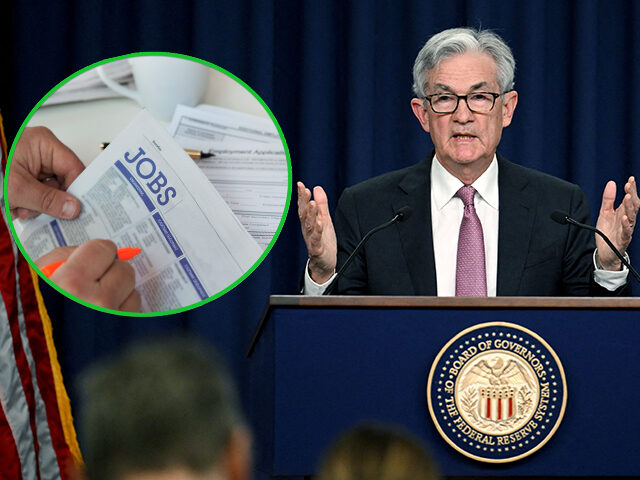If you want to figure out where monetary policy is heading next, watch the labor market.
While lots of attention was focused yesterday on Federal Reserve Chairman Jerome Powell saying that interest rates are likely to go higher than was earlier projected even if the size of the hikes shrinks, the head of the world’s most important central bank also indicated that the Fed’s focus is very much on the labor market right now. “Reducing inflation is likely to require a sustained period of below-trend growth and some softening of labor-market conditions,” Powell said in the opening remarks at his press conference on Wednesday.
Powell noted that we’ve had below-trend growth this year. The economy shrank in the first and second quarters, yet inflation kept rising. Slowing the overall economy has not brought down inflation. What is needed, Powell indicated, is a reduction in demand for workers.
It’s worth quoting Powell at length here:
Despite the slowdown in growth, the labor market remains extremely tight, with the unemployment rate at a 50 year low, job vacancies still very high, and wage growth elevated. Job gains have been robust, with employment rising by an average of 289,000 jobs per month over August and September. Although job vacancies have moved below their highs and the pace of job gains has slowed from earlier in the year, the labor market continues to be out of balance, with demand substantially exceeding the supply of available workers. The labor-force participation rate is little changed since the beginning of the year.
Powell pointed out two things when he was explaining why Fed officials now think interest rates will have to go higher than they expected at the September meeting. First and most importantly, the consumer price index is showing that inflation is still elevated. A close second, however, was the “strong labor market.”
At Wednesday’s press conference, Neil Irwin of Axios pointed out that Fed tightening has hit the housing and tech sector hard but seems to have had little effect on the broader economy. He asked Powell what channels of the economy the Fed expects monetary policy to work through to contain inflation and if they have changed from previous experience.
“I don’t know that the channels through which policy works have changed that much,” Powell said. “I would say a big channel is the labor market and the labor market is just very, very strong, very strong, and households, of course, have strong balance sheets.”
That’s a very clear indication that the Fed is looking at the labor market not just as a source of risk of future inflation but as an indicator of how restrictive policy has become. So long as job growth remains robust, vacancies remain very high, and unemployment very low, the Fed is unlikely to take the view that policy has become restrictive enough to bring down inflation.
Why has job growth remained so high despite contractions in the first half of the year and a looming recession next year? One explanation might be found in the productivity figures released by the Bureau of Labor Statistics on Thursday. Productivity fell in the first half of the year and grew by a paltry 0.3 percent in the third quarter. This interacts with growth in two ways. In the first place, it is harder to grow the economy when productivity is falling or stagnating. This is even more true when labor force participation is persistently low. Perhaps more importantly, employers are likely trying to bring on more workers to grow output because the productivity of the workforce has been disappointing.
The next question, of course, is why productivity has been so low. Some have proposed a phenomenon known as “quiet quitting,” in which workers stay on the job while doing as little work as they can manage. Others have blamed the transition to hybrid work. Less discussed is the possibility that the high rate of quits—as seen in the monthly Job Openings and Labor Turnover Surveys (JOLTS)—may be hurting productivity. When a worker quits, it typically results in two hires. The exiting worker gets hired into a new position and a different worker gets hired into the old position. Since both transitions require training, orientation, and adjustment, this can lower productivity.
Could quitting really be that much of a drag on productivity? Not during ordinary times. But these are not ordinary times. Quits have been extremely high for over a year and a half now. And while they have come down from their highs, they appear to have plateaued at a level that is very elevated by historical standards. The cumulative effect of this could well become an economic drag—at least in the near term. In the long term, presumably people are moving into better jobs that are more suited to their skills and life goals. That should be good for productivity eventually.

The jobless claims numbers Thursday indicate that there has been very little easing of the tightness in the labor market. Just 217,000 people filed initial jobless applications, well below economist expectations. Forecasters keep predicting that claims will increase, and the claims numbers keep surprising to the downside.
Friday’s jobs report for October will give as a broader picture. Economists are expecting a slight easing of labor market conditions. Nonfarm payrolls are expected to rise by 210,000, down from 263,000 in September. The range of predictions, however, is quite wide. Forecasts surveyed by Econoday range from 125,000 to 250,000. That’s an indication of how much uncertainty there is right now. It’s safe to say that if the number comes in above the top of the range, that should be interpreted as a sign the Fed will have to push rates even higher than currently expected. In fact, if we get a big beat, it will probably lock in a 75-basis point hike at the December Fed meeting.

COMMENTS
Please let us know if you're having issues with commenting.